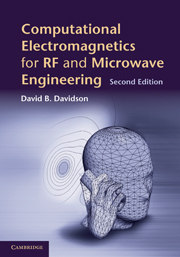Book contents
- Frontmatter
- Dedication
- Contents
- Preface to the second edition
- Preface to the first edition
- Acknowledgements
- To the reader
- List of notation
- 1 An overview of computational electromagnetics for RF and microwave applications
- 2 The finite difference time domain method: a one-dimensional introduction
- 3 The finite difference time domain method in two and three dimensions
- 4 A one-dimensional introduction to the method of moments: modelling thin wires and infinite cylinders
- 5 The application of the FEKO and NEC-2 codes to thin-wire antenna modelling
- 6 The method of moments for surface modelling
- 7 The method of moments and stratified media: theory
- 8 The method of moments and stratified media: practical applications of a commercial code
- 9 A one-dimensional introduction to the finite element method
- 10 The finite element method in two dimensions: scalar and vector elements
- 11 The finite element method in three dimensions
- 12 A selection of more advanced topics in full-wave computational electromagnetics
- Appendix A The Whitney element
- Appendix B The Newmark-β time-stepping algorithm References
- Appendix C On the convergence of the MoM Reference
- Appendix D Useful formulas for simplex coordinates
- Appendix E Web resources
- Appendix F MATLAB files supporting this text
- Index
- References
6 - The method of moments for surface modelling
Published online by Cambridge University Press: 05 July 2014
- Frontmatter
- Dedication
- Contents
- Preface to the second edition
- Preface to the first edition
- Acknowledgements
- To the reader
- List of notation
- 1 An overview of computational electromagnetics for RF and microwave applications
- 2 The finite difference time domain method: a one-dimensional introduction
- 3 The finite difference time domain method in two and three dimensions
- 4 A one-dimensional introduction to the method of moments: modelling thin wires and infinite cylinders
- 5 The application of the FEKO and NEC-2 codes to thin-wire antenna modelling
- 6 The method of moments for surface modelling
- 7 The method of moments and stratified media: theory
- 8 The method of moments and stratified media: practical applications of a commercial code
- 9 A one-dimensional introduction to the finite element method
- 10 The finite element method in two dimensions: scalar and vector elements
- 11 The finite element method in three dimensions
- 12 A selection of more advanced topics in full-wave computational electromagnetics
- Appendix A The Whitney element
- Appendix B The Newmark-β time-stepping algorithm References
- Appendix C On the convergence of the MoM Reference
- Appendix D Useful formulas for simplex coordinates
- Appendix E Web resources
- Appendix F MATLAB files supporting this text
- Index
- References
Summary
The helix antenna discussed in the previous chapter used a new type of element to model surfaces. The theory underlying this is described in this chapter. The basic theory is quite complex, and general implementations are especially challenging. However, by choosing a suitable problem, it proves possible to undertake a limited implementation of a three-dimensional scattering problem, using a basis function defined on a triangular patch known as the RWG element. This is named after Rao, Wilton and Glisson, who introduced the element in their classic 1982 paper [1]. It represented a new type of element, the vector or edge-based element, and a closely related class of element was also under development for finite element applications at that time, although it would be some years before the connection was fully appreciated. (This will be pursued in more detail in the later coverage of the FEM.) The RWG element underlies the surface treatment of modern codes such FEKO (although not NEC), and some examples of using existing codes (in particular FEKO) to compute scattering from more general surfaces will further illustrate this.
We will also see that not only can perfectly (or highly) conducting structures be efficiently modelled using surface currents, but also homogeneous dielectric and/or magnetic regions, using fictitious equivalent currents. (We will even briefly describe how inhomogeneous bodies can be modelled using volumetric currents, but note at the outset that this is not one of the strong points of the MoM.)
Information
- Type
- Chapter
- Information
- Computational Electromagnetics for RF and Microwave Engineering , pp. 201 - 263Publisher: Cambridge University PressPrint publication year: 2010
